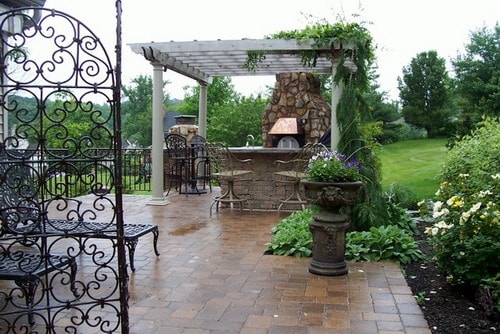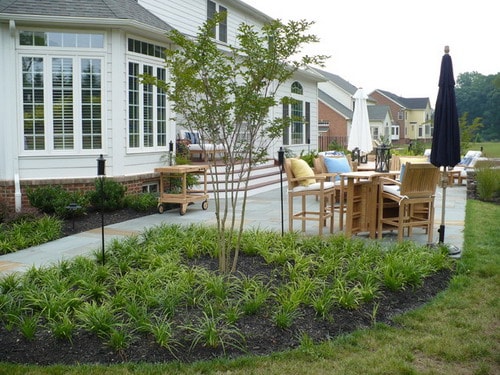Green Outdoor Living Area – Now that we’re deep in the crippling embrace of winter, the grass is really looking greener over on the other side of Spring. Every day you find yourself staring out the frost-flecked window, dreaming about those distant summer plans—the lush garden and sun-drenched cookouts, lazy hammocks and tart lemonade—and especially the deck or patio potential that could be locked beneath the inches of ice.
Of course, when you’re planning a fresh outdoor look, you want to make sure it’s as good for the earth as possible (so as not to trigger more of nature’s icy ire!). But because porch and patio surfaces are built to withstand weather’s worst, they often contain toxic sealants and unnatural materials that don’t really make your home the eco-paradise it’s meant to be.
It pays to be knowledgeable about the types of materials that go into not just your home, but your backyard BBQ, too. But as with many green makeovers, deciding what materials are best can get a little murky. Still, there are some surfaces that should be avoided at all costs. Here’s what to use where when you’re planning Green Outdoor Living Area.
How to Build Green Outdoor Living Area

Sustainable Decks
Nothing looks better shading a verdant lawn than a spacious new deck. But when you want to build one sustainably, things can get a little tricky. In terms of dangerous toxins, natural wood is the most organic option, but of course, new wood accelerates the decline of the world’s rapidly depleting forests. And the curing process burns up even more trees—or worse, coal!—pouring greenhouse gases into the atmosphere. Maybe you’ve considered using the new composite deck boards instead? After all, you think, they’re made with recycled plastic and sawdust left from lumber yard leftovers. But not so fast—because although they get a check in the “reused materials” column, they’re prone to fading and even, in some cases, falling apart.
And then, once you’ve got your deck installed, there’s the treatment. Many stains and sealants are heavily toxic and contain VOCs (volatile organic chemicals), which can worsen asthma and have been linked to cancer and liver and kidney damage.
The solution: If you really can’t see your yard without a glorious hardwood deck, look for locally-sourced lumber that has been certified by Forest Stewardship Council (FSC). Or, if you’re not picky about uniformity, check with nearby lumber suppliers to see if any have experience with salvaged wood (although make sure you get to look at their stash before committing—some reclaimed lumber can be rotted or misshaped).
If you’re flexible about materials, though, consider scrapping the lumber entirely in favor of an aluminum deck—it’s super durable and completely recyclable. But no matter which way you decide to go, make sure you’re picking low-VOC paints and stains for finishing.

Upcycled Hardscaping
Sometimes the most sustainable deck is no deck at all! Patios make a great alternative to wooden surfaces because they can be constructed with totally reclaimed materials. However, again, it’s good to be particular about how you build: cement, asphalt, and concrete, all often used in conventional patios, are made with harmful manufacturing processes. And all those flat, nonporous surfaces inhibit rainwater runoff, contributing to erosion and wreaking havoc on the health of the surrounding turf.
The solution: Recycled materials really are the way to go here. Using reclaimed brick and stone rescues these remnants from the landfill and lends a distinguished patina to your upscale garden party. Additionally, older bricks were often made by hand, which gives their surfaces a visual cache that factory-made bricks just cannot match.
Another material we’re pretty excited about right now is urbanite—broken, reclaimed concrete scavenged from demolition sites. When repurposed into patio tiles, it looks remarkably similar to freshly-quarried flagstone, and it has the same versatility as new concrete, so you can stain it any way you like.
Earth-Positive Paths
Gravel goes down great on a walkway, and it helps root out worrisome weeds and other riffraff. It’s also perfect for drainage, which keeps the local flora flourishing. Unfortunately, aggregate mining spells trouble for the environment, as it releases dust and particles that lower air quality, and the dredging furthers erosion. The chemicals used in quarries can also contaminate nearby waterways, affecting ecosystems for miles around.
The solution: As always, recycled materials are your best bet. Reclaimed and crushed concrete, tumbled glass pebbles, and salvaged stones and gravel all give new life to old castoffs here. Mulch is another option—pine chips produced in lumber processing are a great choice, as these byproducts would likely end up in the trash anyway. We’ve also seen interesting results from paving paths with modular rubber tiles—they’re made from recycled tires and manufactured to look like brick and stone.

But we like the idea of getting a little funky with your footpaths. We’ve seen beautiful walkways made from upturned wine bottles, plastic bottle caps, and reclaimed rail ties—if you’ve got a lot of it, you can build a path with it! That should give you some inspiration to while away those wintry afternoons!
Pingback: Exterior Palisade - Focus On The Advantages Of The Main Models Available - Home Decor Help